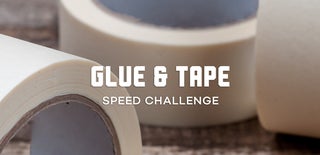Introduction: Cardboard Shoji Lantern
Intro.
The soft glow of candle light has always been an appealing desk accent. Less appealing, however, is the fire hazard it poses with all my papers and notebooks. Using the power of arts and crafts, I created an LED Shoji-style lantern to safely (and aesthetically) mimic candle light.
What is Shoji?
A shoji is a type of Japanese room divider or door. It is typically made of a translucent material mounted on a wooden frame: Wikipedia.
Why Cardboard?
Many people don't have an arsenal of tools at their disposal (me included). This is just an example of a cute project that anybody can make with enough patience and an afternoon to spare. Also, cardboard is light, sturdy, and easily accessible. What's not to love?
Prerequisites:
Patience and a steady hand. Use of Arduino is needed if you want an animated candle flame.
Supplies
- 5 mm Cardboard or thicker
- Gift Tissue Paper (or other thin/translucent paper)
- Hot Glue Gun
- White Glue / Glue Stick
- Pen knife / Exacto knife
- Ruler
- Non-flammable light source of choice
Step 1: CAD Your Design
For most projects, jumping straight into building ends in disaster. Cadding a design allows you to better visualize the final product and minimize mistakes. Due to the simplicity of the lantern, I used TinkerCAD to make a mock-up. If you're making a more complex design, feel free to use programs like Fusion 360 or Solidworks.
(If that's the case, you probably already know what you're doing.)
Tips:
- Make sure you don't design your cardboard too thin! This will make your structure flimsy.
Step 2: Cut Frame Sections
First, mark your cuts using a pencil and ruler. A pen works too, but allows less room for error. Using your knife, carefully cut out the pieces detailed above. This can be done by repeatedly scoring along your marks.
Tips:
- Keep in mind your cutting surface. You probably don't want to scratch up your floor or table, so use a scrap piece of cardboard to act as a cutting board.
- Be patient while cutting! The cleaner and more accurate your cuts are, the better your lantern will look.
- If an edge came out "fuzzy", run a dab of white glue over an edge to smooth out any tufts. Note that this method will only work on minor imperfections.
Step 3: Glue Shade Material
Trim the shade material to desired size. Glue it onto your frame sections using a glue stick or white glue. Let dry in a sunny place for about half an hour.
Tips:
- Leave excess on your trimmed shade material. You can always cut away more, but you can never reattach.
- Cleanliness is key. Make sure your shade material is wrinkled as little as possible.
- Don't use hot glue for this step.
Step 4: Assemble Imitation Flame
While you wait for the shades to dry, assemble your imitation candle flame. For simplicity, I just wrapped a 144 LED/m addressable strip around a sturdy roll of computer paper. Though these LEDs will end up in an enclosed space, the waste heat they produce will not ignite the paper. I paired the strip with an Arduino Nano, but you can work with a less complex light source if you don't require a flame animation.
For simplicity, my method of turning the lantern off is by unplugging the Arduino's USB cable.
Step 5: Assemble All
Now that your "flame" is done and the shades have dried, it's time to fully assemble the lantern. If not using a battery for the lamp, make sure to cut out a discreet hole for a power cable.
For a stronger and cleaner joint, cut out a 5 mm "lip" from one frame section and leave the other alone (see diagram). Gluing the other section into this lip yields a more continuous corner, hiding the core of the cardboard.
Repeat this method for all shade sections.
Finally, I left the top unglued so I could more easily access the internals of the lamp. You don't have to do this if you don't need to physically access the light.
Tips:
- When using with hot glue, work quickly! It solidifies a lot faster than other glues out there.
Step 6: (Optional) Code
To speed up development, I simply modified FastLED's Fire2012 example with a different color palette to create a pleasing candle flame. Feel free to code your own light source.
Step 7: Enjoy!
Enjoy your new relaxing lamp! Feel free to play with the settings of the light to best fit the ambience of your space.
Things to expand on:
- A proper wooden frame?
- A controller / switch?
- A portable lantern?

Second Prize in the
Glue & Tape Speed Challenge














